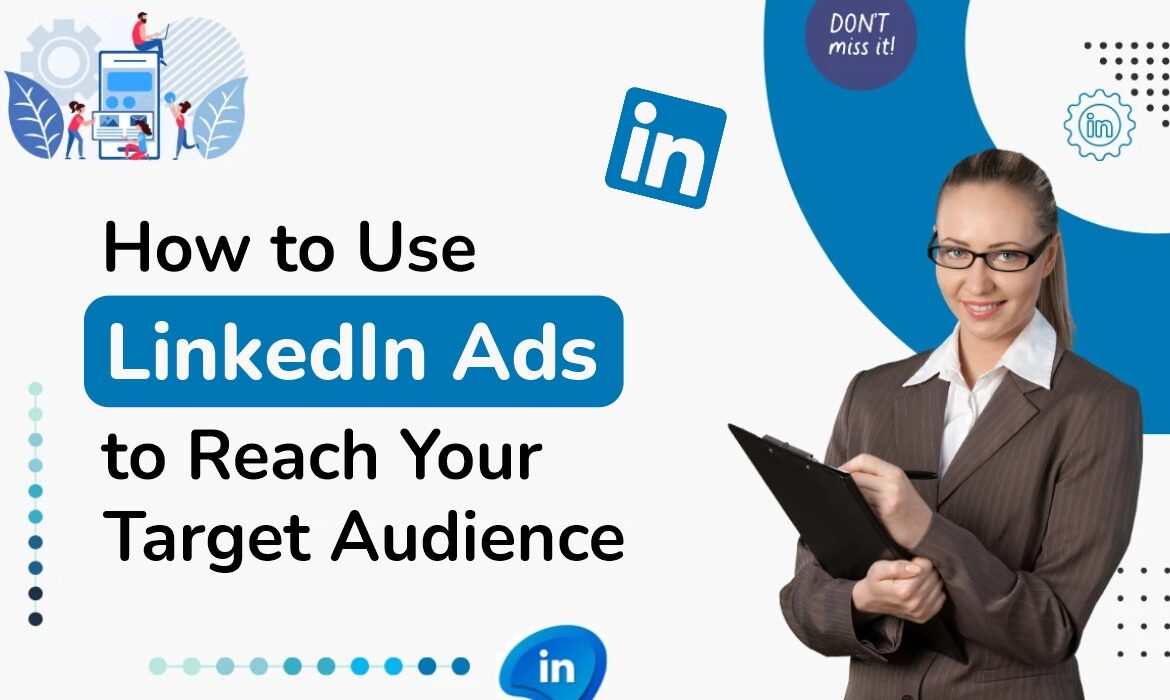- +1 (717) 710 6577
- info@digitalmartlab.com

In the modern business landscape, understanding how to effectively reach your target audience is paramount. Moreover, LinkedIn has emerged as a powerful platform for businesses, especially those focusing on B2B (business-to-business) marketing. With over 900 million professionals globally, LinkedIn provides unique advertising solutions that enable businesses to connect with their ideal clients. In this blog post, we will guide you through using LinkedIn Ads effectively to reach your target audience, with a specific focus on the exceptional services provided by Digital Mart Lab LLC, located in Pennsylvania.
Understanding LinkedIn Ads
First and foremost, LinkedIn Ads are a suite of advertising tools that allow businesses to promote their products and services to a highly targeted professional audience. Unlike other social media platforms, LinkedIn is predominantly used for professional networking, making it an ideal channel for businesses looking to engage decision-makers, industry leaders, and professionals.
The Power of LinkedIn for B2B Marketing
To illustrate, LinkedIn is often regarded as the best platform for B2B marketing due to its professional user base and its focus on career development. Here are some compelling statistics that highlight its importance:
- Over 900 Million Users: With a vast network of professionals, LinkedIn is the largest professional networking platform globally.
- Decision-Makers: Over 61 million LinkedIn users are senior-level influencers, making it an ideal space for targeting executives and business leaders.
- High Engagement Rates: LinkedIn users are 20 times more likely to share content on the platform compared to other social media channels, increasing the potential reach of your ads.
These statistics indicate that businesses can leverage LinkedIn not only to advertise their products but also to build relationships and foster engagement within their target market.
Key Features of LinkedIn Ads
In addition, LinkedIn Ads come with a variety of features designed to maximize the effectiveness of your advertising campaigns:
- Targeted Advertising: LinkedIn’s targeting capabilities are one of its strongest features. You can reach your audience based on various criteria, including:
- Job Title: Tailor your ads to specific roles that are relevant to your product or service.
- Industry: Focus on industries that align with your offerings, ensuring your message reaches the right professionals.
- Company Size: Target businesses of specific sizes to suit your marketing strategy, whether you’re aiming for startups or established corporations.
- Location: Narrow your audience based on geographic regions, which is particularly useful for local businesses.
- Ad Formats: LinkedIn offers a range of ad formats to suit different marketing objectives:
- Sponsored Content: Native ads that appear directly in users’ feeds, allowing for seamless engagement.
- Message Ads: Direct messages sent to LinkedIn members’ inboxes, providing a personal touch to your outreach.
- Dynamic Ads: Personalized ads that utilize users’ profile information to enhance relevance and engagement.
- Text Ads: Simple yet effective ads that can be displayed on the side of the LinkedIn feed.
- Analytics and Reporting: LinkedIn provides in-depth analytics that enable businesses to track the performance of their ads. In other words, you can analyze key metrics such as impressions, clicks, and conversion rates, which help you refine your campaigns and maximize ROI.
- Lead Generation Forms: LinkedIn allows businesses to create lead generation forms that capture user information directly within the platform. As a result, this feature simplifies the process for potential customers to express interest in your services without needing to navigate away from LinkedIn.
- Integration with CRM Tools: LinkedIn Ads can be integrated with various CRM tools, allowing businesses to seamlessly manage their leads and track interactions.
Pros and Cons of LinkedIn Ads
While LinkedIn Ads offer numerous benefits, it’s important to consider both the pros and cons before diving in.
Pros:
- Highly Targeted Audience: The precision targeting capabilities of LinkedIn ensure that your ads reach the right professionals based on job roles, industries, and interests.
- Professional Environment: Users on LinkedIn are generally more receptive to business-related advertisements, making it easier to engage potential clients.
- Increased Brand Awareness: Regular exposure to your brand on LinkedIn can enhance recognition and authority in your industry, leading to improved trust and credibility.
- Lead Generation Opportunities: The lead generation form feature allows businesses to gather valuable leads without redirecting users to a separate landing page, improving conversion rates.
- Cost-Effective for B2B: Although the cost per click (CPC) may be higher than other platforms, the high-quality leads generated can make LinkedIn Ads more cost-effective for B2B companies.
Cons:
- Higher Costs: LinkedIn Ads can be more expensive compared to other social media platforms, which may be a consideration for smaller businesses or startups.
- Limited Ad Formats: On the other hand, while LinkedIn offers several ad types, the options are fewer compared to platforms like Facebook or Instagram, which may limit creativity.
- Complexity: For those new to digital marketing, navigating LinkedIn’s advertising platform can be challenging, requiring time and effort to learn effectively.

Setting Up Your LinkedIn Ads Campaign
To maximize the effectiveness of LinkedIn Ads, follow a structured approach. Here’s a step-by-step guide to help you get started:
Step 1: Define Your Advertising Objectives
Before launching any ad campaign, it’s crucial to establish clear objectives. Consider what you aim to achieve with your LinkedIn Ads. Are you looking to increase brand awareness, generate leads, drive traffic to your website, or promote a specific event? Your goals will guide your strategy and help you measure success.
Step 2: Identify Your Target Audience
Next, utilize LinkedIn’s robust targeting options to define your ideal audience. Consider the following factors:
- Demographics: Age, gender, and education level can influence your messaging.
- Job Titles: Identify specific roles that are relevant to your product or service. For example, if you offer SEO services, you may want to target marketing managers or business owners.
- Industries: Focus on industries that align with your offerings. For instance, if you provide services to healthcare organizations, narrow your targeting to healthcare professionals.
- Geographic Location: Decide whether you want to target a local audience in Pennsylvania or expand to a national or global reach.
Step 3: Choose Your Ad Format
Furthermore, selecting the right ad format is crucial for achieving your campaign objectives:
- Sponsored Content: Use this format to share engaging updates, articles, or case studies that highlight your expertise. This can be particularly effective for promoting the services offered by Digital Mart Lab LLC, such as web design or SEO solutions.
- Message Ads: Direct messaging can create a personalized touch. For instance, consider using this format to send targeted offers or invitations to connect, making your outreach feel more intimate.
- Dynamic Ads: Personalized ads can enhance engagement by utilizing profile information. In particular, showcasing how Digital Mart Lab LLC has helped similar businesses can attract interest.
Step 4: Set Your Budget and Schedule
Next, LinkedIn Ads operate on a bidding system, allowing you to set a budget that suits your needs. Decide whether you want to run a daily or total budget, and choose your bidding strategy, such as cost per click (CPC) or cost per impression (CPM). Keep in mind that while LinkedIn Ads may require a higher budget, the potential returns can outweigh the costs, especially when targeting high-value leads.
Step 5: Craft Compelling Ad Copy
At this stage, your ad copy should be concise, engaging, and tailored to your target audience. Here are some tips for writing effective ad copy:
- Highlight Benefits: Instead of just stating features, focus on the benefits your services provide. For example, emphasize how Digital Mart Lab LLC can help businesses increase their online visibility and generate more leads.
- Use Strong CTAs: A clear call-to-action (CTA) encourages users to take the next step. Phrases like “Get a free consultation” or “Learn more about our services” guide users on what to do next.
- Incorporate Keywords: Moreover, use relevant keywords throughout your ad copy to improve SEO and ensure your ads resonate with the search intent of your audience.
Step 6: Monitor and Optimize Your Campaign
Once your ads are live, continuously monitor their performance. Use LinkedIn’s analytics to track key metrics like:
- Click-Through Rates (CTR): Indicates how effectively your ad encourages users to take action.
- Conversion Rates: Measures how many users complete a desired action, such as filling out a lead form or making a purchase.
- Engagement Levels: Analyze likes, shares, and comments to gauge user interest.
Based on this data, make necessary adjustments to improve your campaign’s effectiveness. For instance, if a particular ad is performing well, consider increasing its budget or duplicating its strategy for other campaigns.
Crafting Effective LinkedIn Ads
Creating effective LinkedIn Ads requires a combination of creativity and strategic thinking. Here are additional tips to enhance your ad campaigns:
1. Use High-Quality Visuals for LinkedIn Ads
To begin with, eye-catching visuals can significantly impact ad performance. Use high-quality images or videos that resonate with your target audience. If you’re promoting the services of Digital Mart Lab LLC, consider showcasing successful projects or testimonials from satisfied clients.
2. Leverage Client Testimonials for LinkedIn Ads
Furthermore, incorporating testimonials from previous clients can enhance credibility and trust. Prospective customers are more likely to engage with ads that feature real feedback from businesses that have benefited from your services.
3. A/B Testing for LinkedIn Ads
Moreover, A/B testing is crucial for optimizing your ad performance. Test different headlines, visuals, and CTAs to determine which elements resonate best with your audience. As a result, you can refine your ads for maximum effectiveness.
4. Align Ads with Landing Pages for LinkedIn Ads
Additionally, ensure that your ad content aligns with the landing page it directs users to. A cohesive message from the ad to the landing page increases the chances of conversion. If your ad promotes a special offer from Digital Mart Lab LLC, ensure that the landing page provides further details and an easy way for users to take action.
5. Utilize Retargeting Campaigns for LinkedIn Ads
Finally, retargeting allows you to reach users who have previously engaged with your ads or visited your website. This strategy can help keep your brand top-of-mind and encourage potential clients to revisit your services. For example, if a user showed interest in your web design services but didn’t convert, retarget them with a relevant ad showcasing a recent project.
Conclusion
In conclusion, LinkedIn Ads can be a game-changer for businesses looking to reach their target audience effectively. By understanding the platform’s features, crafting compelling ad content, and leveraging data-driven strategies, you can enhance your advertising efforts and drive meaningful engagement with potential clients.
At Digital Mart Lab LLC, we specialize in helping businesses maximize their online presence through targeted advertising strategies, including LinkedIn Ads. Located in Pennsylvania, we are dedicated to providing tailored solutions that meet your unique needs. Whether you’re looking to increase brand awareness, generate leads, or drive traffic to your website, our team of experts is here to help.
So, are you ready to elevate your advertising game on LinkedIn? Contact us today at +1 (717) 710-6577 or visit www.digitalmartlab.com to learn more about our services and how we can assist you in reaching your target audience effectively. We make websites according to your business based on your preference, ensuring you receive the best possible service tailored to your needs.


